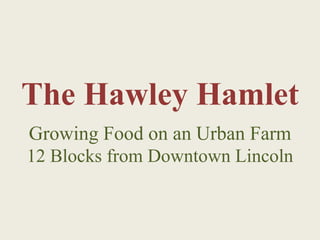
Assurity insurance talk
- 1. The Hawley Hamlet Growing Food on an Urban Farm 12 Blocks from Downtown Lincoln
- 2. My First Toyota Prius (2003) Yes, I am a ‘Prius Driver’
- 6. Why do we always plant things that we can’t eat?
- 7. Home, Sweet Home (prior to 2009)
- 8. The largest irrigated crop in America is the lawn. According to NASA, there are three times more acres of lawns in the U.S. than irrigated corn — enough to cover the entire state of Ohio.
- 9. The average bite of food on our plate travels 1,346 miles to get there. “U.S. Agriculture: Potential Vulnerabilities.” Stanford Research Institute, Menlo Park, CA. Prepared for: Office of Civil Defense, Office of the Secretary of the Army January 1969 About one-fifth of all food consumed in the U.S. is imported. U.S. Government, 2014
- 10. California Central Valley The California Central Valley is the source of 70% of all the lettuce consumed in the U.S. U.S. Drought Monitor Map of California - February 10, 2015 D0 - Abnormally Dry D1 - Moderate Drought D2 - Severe Drought D3 - Extreme Drought D4 - Exceptional Drought The brown-colored area is the worst condition of “Exceptional Drought” The U.S. Drought Monitor is jointly produced by the National Drought Mitigation Center at the University of Nebraska-Lincoln, the United States Department of Agriculture, and the National Oceanic and Atmospheric Administration. Map courtesy of NDMC-UNL.
- 11. percent of the $4.4 billion Nebraskans annually spend on food leaves the state…
- 12. Five Good Reasons To Grow Our Own Food 1. Good Taste (local is fresher) 2. Good Health (local is more nutritious) 3. Good Business (local is economically advantageous) 4. Good Stewardship (local is resource-efficient) 5. Good Security (local is more reliable)
- 14. …and as of September 2014
- 15. Our Lawn-free Front Yard with Bee-friendly, Drought-tolerant Perennials
- 17. Growing Food for Bees and People in the Public Right-of-Way
- 19. Looking for the ‘Huh’ Factor ( *Notice all the lawns up the block… )
- 20. What the Neighbors have to look at…
- 25. The Movie Stars As featured on NET’s “Backyard Farmer” The Movie Stars As featured on NET’s “Backyard Farmer”
- 27. Plat map for ‘The Hamlet’ – our city block bounded by 25th & 26th Streets and ‘T’ & ‘U’ Streets in the Hawley Neighborhood Historic District near Downtown Lincoln (photo taken 2010)
- 49. United Nations: “Of the 100 crop species that provide 90 percent of the world’s food, over 70 are pollinated by bees.”
- 50. A panoramic view of part of the Hamlet’s six tenths of an acre neighborhood garden & orchard in the interior of the block (photo taken July 2012)
- 56. Strawberry Lawn
- 57. Summer
- 58. FALL
- 66. The Urban Gardener’s Goal To put something home-grown on the table every day — whether it’s fresh, stored, canned, fermented, dried or frozen. In an urban environment, ‘self-sufficiency’ will never be an option. There’s no room in town for fields of corn and wheat and we can’t keep the animals we need for dairy and meat. But even at the city block level, we can be growing fresh greens year-round, preserving our garden harvest, and keeping bees and a couple of chickens for eggs. We’ll be making more efficient and responsible use of available resources, getting plenty of exercise and giving ourselves a daily reminder of how that food got on the table.
- 67. Locavore: One who eats foods grown locally whenever possible, generally within 50-100 miles of home. Locavores connect more closely with their food sources by supporting local farmers and businesses — relishing in the pleasure of eating fresher, more nutritious foods while reducing the carbon footprint of food production, packaging and transportation.